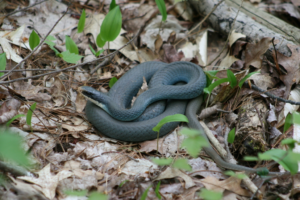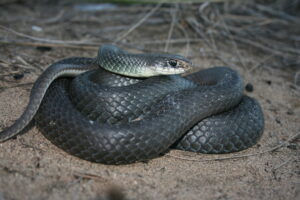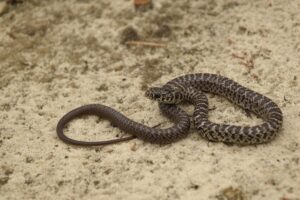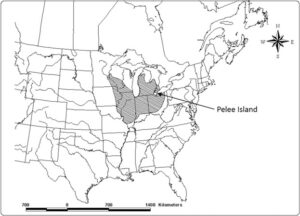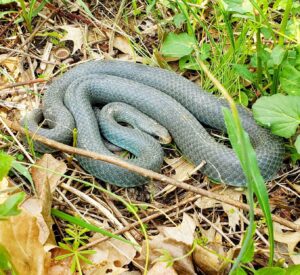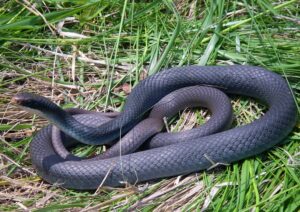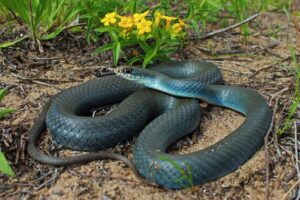The blue racer snake is a diurnally active subspecies of the eastern racer. Being intolerant of high levels of human activity for most of its active season, the colubrid tends to stay in areas with low human population density. In fact, they are one of the first snakes to disappear from developing suburban areas.
Scientific Classifications
- Suborder:Serpentes
- Family:Colubridae
- Genus:Coluber
- Species:C. constrictor
- Subspecies:C. c. foxii
Conservation Status
Description
Size
One of Ontario’s largest snakes reaches a snout-to-vent length (SVL) of 90 cm-152 cm. The longest blue racer caught on Pelee Island had an SVL of 138 cm.
Color and Appearance
The beautiful snake has dull gray to brilliant blue lateral scales, creamy white ventral scales, and a pale brown to dark gray dorsum. It also has characteristic black masks formed by black scales around its comparatively large eyes and often sports brownish-orange rostral scales (snouts).
Unlike adults, the hatchlings and yearlings (first complete active season) have dorsal blotches that fully fade by the third year. However, the juvenile pattern is still visible on the snake’s venter till late in the third season.
Are They Dangerous to Humans
When threatened, the blue racer escapes into a bush or tries to climb small trees or low bushes. It can also vibrate its tail, creating a buzzing sound reminiscent of rattlesnakes. Though non-venomous, the colubrid can inflict a painful bite when cornered.
Blue Racers at a Glance
Distribution
Extant populations can only be found in the states of Indiana, Ohio, Illinois, Wisconsin, Michigan, and Iowa in the United States. The last recorded existence of the snake in mainland Canada was in Ontario, way back in 1983. It is limited to the eastern two-thirds of Pelee Island in Ontario.
Habitat
They prefer semi-open, old field shoreline, savanna, and edge habitats. A mosaic of these habitats likely fulfills the ecological needs of the serpent.
Lifespan
The blue racer lives for 15-20 years in the wild.
Predators
Probable predators of the racer are larger birds of prey, for example, northern harrier, red-tailed hawk, great-horned owl, etc., and carnivorous mammals like foxes, raccoons, and coyotes. Feral house cats and dogs can harass or kill the baby snakes. A wider variety of avian and mammalian predators consume the racer’s eggs.
Diet
The terrestrial and arboreal foragers primarily consume songbirds, rodents, and other snakes. The babies may eat crickets and other insects.
Reproduction
Oviparous (lays eggs that hatch outside the body)
The males are physiologically mature at 11 months of age but cannot mate till the end of the second year due to a lack of opportunities. Similarly, females mature when they are 2 years old but cannot mate till the following year.
Mating starts in April and continues through May. Eggs are laid in communal nesting sites, under big rocks, in mounds of decaying organic matter and fallen rotting logs, in late June. The average clutch size is 12-17. Though they can reproduce annually, biennial cycles are more common. Mid-August to late September is when the eggs hatch.
Care Sheet
It can be kept as a pet only by experienced snake keepers, not beginners. It is because the snake can be flighty and prone to biting.
Size of the Enclosure: A tank of a minimum 100-gallon capacity should be used to house an adult.
Temperature: A temperature gradient of 80-85°F should be maintained in the pet set up during the day. At night it can fall to as low as 70°F.
Humidity: The ideal humidity for the tank is 40-50%. A water bowl shallow enough for the snake to climb in and out easily should be provided.
Substrate: Wood shavings (avoiding cedar and pine), paper towels, or coconut fiber are suitable substrates.
Feeding: The pets should be fed pre-killed mice (either pinkies or adults) during day time.
FAQs
Ans. True to its name, the blue racer is a very fast snake that can move at a speed of almost 7 km per hour.
Ans. Blue racers are very fast, but they don’t chase people.
Ans. They are endangered due to habitat loss and degradation, human persecution, loss of overwintering sites, and road mortality.
Ans. Blue racers can get pretty aggressive on being cornered.
Source
publish0x.com, collinsdictionary.com, live.staticflickr.com, canada.ca, pbs.twimg.com, wildlifepreservation.ca, rare-gallery.com

